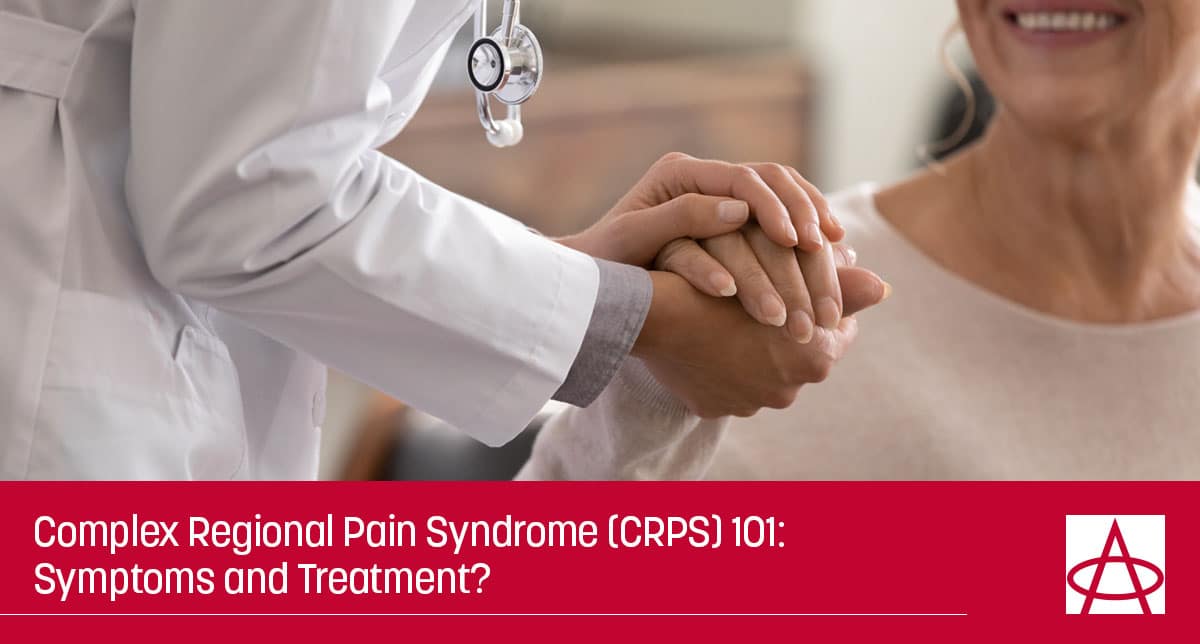
Complex Regional Pain Syndrome (CRPS) 101: Symptoms and Treatments
By Advanced Pain Care
Complex Regional Pain Syndrome (CRPS) is a condition where you have pain in your upper and lower extremities (arms, legs, hands, and feet). Doctors do not quite know the cause of this condition. Still, most believe it is usually caused by an injury to the peripheral (nerves outside the brain and spinal cord) and central nervous systems (CNS) (consisting primarily of the brain and spinal cord nerves).
According to studies, tissue trauma due to injuries may stimulate the immune system to release inflammatory chemicals into the affected area. According to other research, the cause may be to impair or alter the nervous system. This malfunction may be triggered by tissue damage and the increased activity in the CNS and sympathetic nervous system (the nerves connected to your fight or flight response).
The two types of CRPS
There are two types of CRPS that occur, which have very similar symptoms but different causes. Type 1 is known as Reflex Sympathetic Dystrophy (RSD). This version typically occurs after an illness or injury that didn’t directly damage the nerves in the affected limb. Most people have CRPS Type 1; in fact, 90% suffer from this type.
Type 2 is referred to as causalgia, which means that after a direct and distinct injury in the peripheral nerves, you can develop CRPS. The symptoms for Type 2 are very similar to Type 1, except Type 2 is more direct in its causation than Type 1.
Both are diagnosed by your doctor, who will likely go through the process of reviewing your medical history and symptoms and give you a physical examination. You may be asked to do some imaging testing, such as an ultrasound or MRI, to check whether you have any underlying nerve damage. However, finding underlying nerve damage is not always possible, even if you do show signs of having CRPS.
If you present no signs of nerve damage, your doctor will likely ask you to elaborate on any recent injuries or surgeries to rule out any other pain disorders. If you have experienced any illness or injury where you are presenting the same or similar symptoms of CRPS, you may still be diagnosed and treated for it.
Symptoms of CRPS
The main symptom of CRPS is burning pain. It may differ in degree and severity, but most pain sensations are reported to be greater than the pain of the injury or trauma itself. You may also experience skin swelling, decreased function in your affected extremities, and changes in skin temperature, skin color, and texture discoloration. You may also experience a lack of hair or nail growth.
Treatment of CRPS
Noninvasive therapy
It’s important to continue moving and exercising even when you suffer from CRPS. Moving the affected limb allows you to maintain flexibility and prevent the loss of muscle in the local area.
Pain and mental health disorders often go hand and hand. Therefore, if you are experiencing a prolonged low or poor mood, depression, or anxiety, talk to your primary care physician to see if they can refer you to a psychologist or psychiatrist. They will be able to support your mental health and your overall well-being to cope with your condition.
In addition, focus on things that you enjoy doing or spend time with your family and friends for support. Chronic pain can get worse and intolerable if your mental health is in decline. Both chronic pain and mental health issues can disrupt your sleeping and eating patterns and increase your stress levels which can cause increased inflammation in the body and worsen your CRPS.
There are also several different prescription and non-prescription-based medications that you can utilize. Those include steroids for inflammation; blood pressure medications; drugs that can help prevent or slow bone loss, and antidepressants.
Invasive treatment
Once diagnosed with CRPS, you may be prescribed Sympathetic Nerve Blocks. They numb the pain of the affected limb. The Lumbar Sympathetic Block involves injecting an anesthetic next to your low back for lower extremity pain. For your neck or upper limb pain, your doctor will likely prescribe Stellate Ganglion Blocks, which involve injecting an anesthetic on the side of your neck. These treatments are for early-stage CRPS and simply help to mobilize the extremity to relieve the pain.
Another effective treatment is Spinal Cord Stimulation (SCS), where your doctor will insert tiny electrodes along your spinal cord. The SCS has proven to sustain pain relief from inflammation for some time and serves as a more effective treatment compared to blockers. To ensure that it works for you, your doctor will first do a trial run before implantation.
Depending on the severity of your condition, you may have the option to get surgery. Your doctor will cut the affected nerves to prevent painful impulses from reaching the brain. However, this is not for someone who has an early diagnosis of CRPS. Surgery is only recommended for the most severe cases that don’t respond to the other treatments mentioned earlier.
It is important that if you are experiencing constant and severe pain that affects a limb, making touching or moving that limb intolerable, you should talk to your doctor immediately. Your pain can be more manageable, and you can maintain your mobility when you treat CRPS early.






